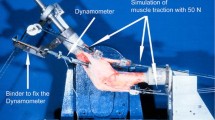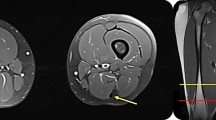Abstract
A decrease of deep knee flexion torque after anterior cruciate ligament (ACL) reconstruction, using a semitendinosus (and gracilis) tendon, has been reported. However, the cause of this weakness remains controversial. Architectural and functional differences in the knee flexor muscles influence this weakness. the fiber length of the semitendinosus, gracilis, semimembranosus, and biceps femoris were directly measured in six human cadavers. The flexion torque and EMG of the hamstrings were measured in both limbs of 16 patients (23±5 years) after ACL reconstruction (12–43 months post-operation), using ipsilateral semitendinosus tendon. Magnetic resonance imagings were taken, over both the thighs of those patients, to measure muscle volume and to confirm a state of semitendinosus tendon regeneration. The position of the musculotendinous junction of the semitendinosus was also analyzed. The fiber length of the semitendinosus and gracilis were three to four times longer than that of the semimembranosus and biceps femoris. The difference of flexion torque between the normal and ACL reconstructed limbs significantly increased as the knee flexion angle increased. The EMG value for the semimembranosus and biceps femoris of both limbs as well as the semitendinosus of the ACL reconstructed limbs, significantly reduced as the knee flexion angle was increased. The volume of the semitendinosus in the reconstructed limb was significantly smaller than in normal limbs. The regeneration of the semitendinosus tendon was confirmed in all subjects, and the musculotendinous junction position of the reconstructed limb in almost all subjects was found in further image from the knee joint space than that for the normal limb. The decrease of deep knee flexion torque, after ACL reconstruction, could be due to the atrophy and shortening of the semitendinosus after its tendon has been harvested, as well as the lack of compensation from the semimembranosus and biceps femoris, due to the architectural differences between the semitendinosus and the semimembranosus and biceps femoris.










Similar content being viewed by others
References
Aglietti P, Buzzi R, Zaccherotti G, et al (1994) Patellar tendon versus doubled semitendinosus and gracilis tendons for anterior cruciate ligament reconstruction. Am J Sports Med 22:211–218
Akima H, Kuno S, Fukunaga T, et al (1995) Architectural properties and specific tension of human knee extensor and flexor muscles based on magnetic resonance imaging. Jpn J Phys Fitness Med 44:267–278
Armour T, Forwell L, Litchfield R, et al (2004) Isokinetic evaluation of internal/external tibial rotation strength after the use of hamstring tendons for anterior cruciate ligament reconstruction. Am J Sports Med 32:1639–1643
Carter TR, Edinger S (1999) Isokinetic evaluation of anterior cruciate ligament reconstruction: hamstring versus patellar tendon. Arthroscopy 15:169–172
Corry IS, Webb JM, Clingeleffer AJ, et al (1999) Arthroscopic reconstruction of the anterior cruciate ligament. A comparison of patellar tendon autograft and four-standard hamstring tendon autograft. Am J Sports Med 27:444–454
Cross MJ, Roger G, Kujawa P, et al (1992) Regeneration of the semitendinosus and gracilis tendons following their transection for repair of the anterior cruciate ligament. Am J Sports Med 20:221–223
Delagi EF (1981) Anatomic guide for the electromyographyer, 2nd edn. Charles C Thomas, Springfield, IL
Eriksson K, Anderberg P, Hamberg P, et al (2001) A comparison of quadrupled semitendinosus and patellar tendon grafts in reconstruction of the anterior cruciate ligament. J Bone Joint Surg Br 83:348–354
Eriksson K, Larsson H, Wredmark T, et al (1999) Semitendinosus tendon regeneration after harvesting for ACL reconstruction. A prospective MRI study. Knee Surg Sports Traumatol Arthrosc 7:220–225
Frank CB, Jackson DW (1997) The science of reconstruction of the anterior cruciate ligament. J Bone Joint Surg Am 79:1556–1576
Friederich JA, Brand RA (1990) Muscle fiber architecture in the human lower limb. J Biomech 23:91–95
Harter RA, Osternig LR, Singer KM, et al (1988) Long-term evaluation of knee stability and function following surgical reconstruction for anterior cruciate ligament insufficiency. Am J Sports Med 16:434–443
Herzog W (1993) Lines of action and moment arms of the major force-carrying structures crossing the human knee joint. J Anat 182:213–230
Karlson JA, Steiner ME, Brown CH, et al (1994) Anterior cruciate ligament reconstruction using gracilis and semitendinosus tendons. Comparison of through-the-condyle and over-the-top graft placement. Am J Sports Med 22:659–666
Lipscomb AB, Johnston RK, Snyder RB, et al (1982) Evaluation of hamstring strength following use of semitendinosus and glacilis tendons to reconstruct the anterior cruciate ligament. Am J Sports Med 10:340–342
Maeda A, Shino K, Horibe S, et al (1996) Anterior cruciate ligament reconstruction with multistranded autogenous semitendinosus tendon. Am J Sports Med 24:504–508
Nakajima R, Maruyama Y, Ichiao K, et al (1996) Decreased hamstring strength after harvest of semitendinosus and gracilis tendons for anterior cruciate ligament reconstruction. J Jpn Clin Sports Med Assoc 6:681–686
Nakamura N, Horibe S, Sasaki S, et al (2002) Evaluation of active knee flection and hamstring strength after anterior cruciate ligament reconstruction using hamstring tendons. Arthroscopy 18:598–602
Ohkoshi Y, Inoue C, Yamane S, et al (1998) Changes in muscle strength properties caused by harvesting of autogenous semitendinosus tendon for reconstruction of contralateral anterior cruciate ligament. Arthroscopy 14:580–584
Papandrea P, Vulpiani MC, Ferretti A, et al (2000) Regeneration of the semitendinosus tendon harvested for anterior cruciate ligament reconstruction. Evaluation using ultrasonography. Am J Sports Med 28:556–561
Rispoli DM, Sanders TG, Miller MD, et al (2001) Magnetic resonance imaging at different time periods following hamstring harvest for anterior cruciate ligament reconstruction. Arthroscopy 17:2–8
Rosenberg TD, Brown GC, Deffner KT (1997) Anterior cruiciate legament reconstruction with a quadrupled semitendinosus autograft. Sports Med Arthrosc Rev 5:51–58
Rosenberg TD, Deffner KT (1997) ACL reconstruction: semitendinosus tendon is the graft of choice. Orthopedics 20:396–398
Rosenberg TD, Graf B (1994) Techniques for ACL reconstruction with Multi-Trac drill guide. Acufex Microsurgucal, Mansfield MA
Rowden NJ, Sher D, Rogers GJ, et al (1997) Anterior cruciate ligament graft fixation. Initial comparison of patellar tendon and semitendinosus autografts in young fresh cadavers. Am J Sports Med 25:472–478
Sachs RA, Daniel DM, Stone ML, et al (1989) Patellofemoral problems after anterior cruciate ligament reconstruction. Am J Sports Med 17:760–765
Sakane M, Fox RJ, Woo SL-Y, et al (1997) In situ forces in the anterior cruciate ligament and its bundles in response to anterior tibial loads. J Orthop Res 15:285–293
Shaieb MD, Kan DM, Chang SK, et al (2002) A prospective randomized comparison of patellar tendon versus semitendinosus and gracilis tendon sutografte for anterior cruciate ligament reconstruction. Am J Sports Med 30:214–220
Shino K, Nakata K, Horibe S, et al (1993) Quatitative evaluation after arthroscopic anterior cruciate ligament reconstruction: allograft and autograft. Am J Sports Med 21:609–616
Simonian PT, Harrison SD, Cooley VJ, et al (1997) Assessment of morbidity of semitendinosus and gracilis tendon harvest for ACL reconstruction. Am J Knee Surg 10:54–59
Tashiro T, Kurosawa H, Kawakami A, et al (2003) Influence of medial hamstring tendon harvest on knee flexor strength after anterior cruciate ligament reconstruction. Am J Sports Med 31:522–529
Trotter JA (1993) Functional morphology of force transmission in skeletal muscle. A brief review. Acta Anat (Basel) 146:205–222
Viola RW, Sterett WI, Newfield D, et al (2000) Internal and external tibial rotation strength after anterior cruciate ligament reconstruction using ipsilateral semitendinosus and gracilis tendon autografts. Am J Sports Med 28:552–555
Wickiewicz TL, Roy RR, Powell PL, et al (1983) Muscle architecture of the human lower limb. Clin Orthop 179:275–283
Winters JM, Woo SL (1990) Multiple muscle systems. Springer, Berlin Heidelberg New York, pp 732–736
Woo SL-Y, Orlando CO, Camp JF, et al (1986) Effects of postmortem storage by freezing on ligament tensile behavior. J Biomech 19:399–404
Yasuda K, Tsujino J, Ohkoshi Y, et al (1995) Graft site morbidity with autogenous semitendinosus and gracilis tendons. Am J Sports Med 23:706–714
Author information
Authors and Affiliations
Corresponding author
Rights and permissions
About this article
Cite this article
Makihara, Y., Nishino, A., Fukubayashi, T. et al. Decrease of knee flexion torque in patients with ACL reconstruction: combined analysis of the architecture and function of the knee flexor muscles. Knee Surg Sports Traumatol Arthrosc 14, 310–317 (2006). https://doi.org/10.1007/s00167-005-0701-2
Received:
Accepted:
Published:
Issue Date:
DOI: https://doi.org/10.1007/s00167-005-0701-2




